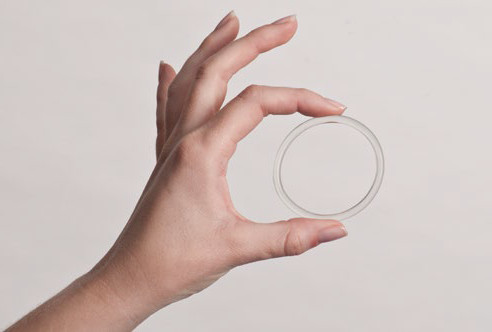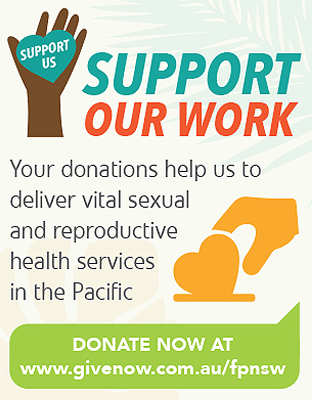Vaginal Ring (NuvaRing)
What is a vaginal ring?
The vaginal ring is a soft plastic ring which contains two types of hormones - an oestrogen and a progestogen. These hormones are similar to the ones made in your ovaries and are like the hormones that are in the contraceptive pill. In Australia the only vaginal ring you can buy is called NuvaRing.

How does the vaginal ring work?
You put the vaginal ring into your vagina. The vaginal ring releases hormones. The hormones are absorbed through the walls of the vagina. It mainly works by stopping your ovaries from releasing an egg (ovulation) and it also makes the mucus in the cervix thicker so that sperm can't get into the uterus.
The vaginal ring stays in your vagina for 3 weeks. After 3 weeks you take the ring out. You leave it out for 1 week. During this week you will have a withdrawal bleed like a period. You put a new ring in at the end of the ring-free week.
You can talk to your doctor or nurse about skipping the withdrawal bleed by running rings together without a break. Most women cannot feel the vaginal ring once it is in place. Your doctor or nurse will tell you the best time to put the first ring in your vagina.
How well does the vaginal ring work?
If it's used correctly, the vaginal ring is 99.5% effective, however in real life it can be less effective (93%) if you forget to take it out or put it back on time. Some medications might stop it working properly, like some epileptic medications or herbal preparations. Talk to your doctor before you start any new medications as you might need to change to a different contraceptive method.
Who can use the vaginal ring?
Most women can use the vaginal ring. The vaginal ring can be a good choice for women who find it hard to remember to take a pill every day. There are some medical reasons which mean that using a vaginal ring is not recommended.
These include:
- a history of deep venous thrombosis (blood clot in a vein), stroke, heart attack or some other types of heart disease
- a condition which makes you more prone to blood clots
- severe liver problems or liver cancer
- certain types of migraine (migraine with aura)
- breast cancer
- some types of systemic lupus erythematosus (SLE)
or if you:
- are over 35 years old and smoke
- have just had a baby (the vaginal ring can generally be started 6 weeks after delivery)
- are taking other medicines which can reduce the effectiveness of the ring including epileptic medications and some herbal remedies
Your doctor will help you decide if you can use the ring or if there is a more suitable method if you have:
- high blood pressure
- diabetes
- body mass index (BMI) of 35 Kg/m2 or more
- a family history of deep vein thrombosis in a close relative
- gallbladder disease
It is important to talk to your doctor or nurse to see if the vaginal ring is a good choice for you. If you are at risk of sexually transmitted infections (STIs) you can use condoms at the same time as using the ring.
Advantages
- It works well when it is used correctly
- No need to remember to take a pill every day
- You can put it in yourself
- Your fertility returns to normal straight away when you stop using it
- It can help to control your periods:
- your bleeding will be regular, lighter and may be less painful
- if you do not want to have any bleeding you can put a new ring in straight away - you should speak to your doctor about this
- It may improve premenstrual syndrome (PMS)
- It may improve acne
Disadvantages
- It doesn't protect against sexually transmissible infections (STIs)
- It can't be used by women who cannot use oestrogen for medical reasons
- There is a small risk of blood clots in the veins (deep vein thrombosis)
- There is an extremely small risk of heart attack and stroke (this is increased if you smoke, have diabetes or high blood pressure)
- It can be associated with hormonal side-effects similar to the Pill including:
- headache - nausea or bloating
- breast tenderness
- acne
- mood changes
- patchy brown marks on the skin of your face
- lowered interest in sex
- spotting or break through bleeding
- You have to be comfortable putting something in your vagina
- Some women have trouble keeping it in place
- You have to remember to take it out after 3 weeks and to put a new one in again 1 week later
- It can be more expensive than some pills
How do I insert and remove the vaginal ring?
To insert the ring:
- squeeze the ring between your thumb and index finger
- gently push the ring into your vagina
To remove the ring:
- put your finger into your vagina
- hook your finger around the ring and pull the ring out
Where can I get a vaginal ring?
You need to see a doctor to get a prescription for the vaginal ring - take the prescription to a pharmacy to buy the ring. You need to use the vaginal rings within 4 months of buying them. They do not need to be stored in the fridge.
For more information
Family Planning NSW Talkline - www.fpnsw.org.au/talkline or 1300 658 886
National Relay Service (for deaf people) - 13 36 77
TIS National's interpreting service - 131 450
Visit your nearest Family Planning NSW clinic - www.fpnsw.org.au/clinics
Family Planning NSW client resource on contraception - What suits me?


